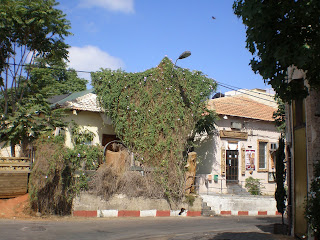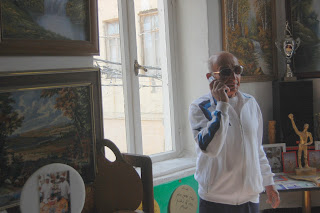 The three-day weekends I've been taking recently are good for the soul and should be encouraged. That extra day also gives my Olympus and I more opportunities to ignore the news, descend from the rooftop and get out and about.
The three-day weekends I've been taking recently are good for the soul and should be encouraged. That extra day also gives my Olympus and I more opportunities to ignore the news, descend from the rooftop and get out and about.Above is a corner in Neve Tsedek opposite the Nana restaurant: a corner yet to be bought out by yuppies. The original Neve Tzedek house on the left is swathed in 'morning glory' creepers that are part of the landscape around here. But fewer and fewer of these untamed preserves are to be found as the construction boom continues. The house on the right is a centre for wood carving. I passed by there one night and encountered the bizarre sight of 5 burly men furiously chisseling and carving away.
Eliyahu (70) the neighbourhood sandlar (shoe-repairer) who for the past 23 years has plied his trade in the same hole-in-the-wall sandlaria on the edge of Neve Tzedek. Soon he will be looking at the ground floor of a massive residential tower now under construction a few metres from his old metal door . Eliyahu came here from Buchara when he was "39-40" but his Hebrew is still patchy. On the earnings from his business, he and his wife managed to bring up 5 boys, all of whom are now mesudarim (taken care of financially) , and some of whom, baruch ha-shem, are already grandfathers themselves. So he's not complaining.
On the way home from dropping my car off at the garage in Florentin, I ran into the backside of the monstrous Neve Tzedek Tower, now clearly nearing completion. Thankfully, part of the ground floor has been built on stilts which, at least at street level somewhat diminishes the impression of a massive impenetrable wall. The white building in the background is one of the Templer buildings undergoing restoration, part of the deal allowing this greedy monster to rise.
But when you look up ....






Comments